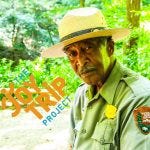Veterinarian and photographer Dag Goering is the co-founder with his wife author Maria Coffey in the adventure touring business Hidden Places Travel. For many years he's worked at combining his love of travel with the care and protection of animals. “It all started with Camels really,” he said in an interview. “I was very interested in doing longer journeys across the Sahara with the Tuaregs.” The Tuaregs are a nomadic people who travel across the deserts of Northern Africa on caravans of camels. So Goering tried to find a way to come along. “I thought as a veterinarian, that’s my background I could bone up on some camel medicine,” he said. “And that might make me useful.” So he did some researched and someone suggested that he go to Bikaner in India, a desert region of Rajasthan. There he hoped to learn a few thing about camels. But he was surprised to discover that camels weren’t as popular as he thought. “Everyone said, “well ‘Camels? Why are you interested in Camels? Camels are nasty animals.’” Goering said. “ And after working there for a couple of weeks in the clinic with camels I came to the conclusion they are indeed nasty animals. Unfortunately, he didn't learn very much. And disappointed but not discourage Goering decided to stay in India and travel. Along the way he wound up working with a non-profit organization that does volunteer veterinary medicine for camels dogs and other animals. “And at one point we were called out to examine this newly born elephant,” he said. “So I was in the presence of all these magnificent large animals in these stables, elephant stables, and it was such a profound experience I just came home and said Maria I just want to work with elephants!” Making the shift from camels to elephants Goering and his wife Maria Coffey began focusing their attention on the care and treatment of elephants. Through their non profit Elephant Earth Initiative to two work now to protect the habitats of elephants in the wild and their welfare among humans in captivity the couple raise awareness for the plight elephants both in Asia and in Africa “There are huge issues to do with the welfare of captive elephants. One of the things that we bring across in our presentation is how captive elephants are trained, are broken and then how they're kept after that, the welfare issues about that. Most people just have no idea of the cruelty that's inflicted upon captive elephants,” Coffey said. “ And then of course in the wild, like any mega-fauna they're being hugely effected by population growth, by the loose of habitat, the growth of human elephant conflict. In many places around the world it's becoming a very big issue. Elephants are very important to us and to world as a whole. Doug and I passionately believe that we have to do what we can to help preserve them.” I had the pleasure of meeting Goering and Coffey during the 2011 Banff Mountain Film Festival in Alberta Canada. There they had on display an amazing assortment of elephant photographs that help to tell the story behind this magnificent but endangered animal in the presentation they call Elephant Enigma. JTP: In your presentation I heard you say that the eye of an elephant is like looking into orb into another world. And a lot of that imagery comes out in many of your photographs. What is it about the eye of an elephant that is so transformational? Goering: Well it is a bit difficult to describe. I think there is a strange energy, you know elephants don't have expressive faces. They're not like dogs. Dogs can sort of grimes or smile. But elephants don't have that kind of musculature. So when you look at their faces they don't really move that much, but the eyes are more expressive. It's not like other animals' eyes. It's more like the eye of a whale if anyone has ever experienced that, I could just compare it to that. And it really is like...you just know that there's something pretty profound going on behind that.
Share this post

Elephant Engima – The Joy Trip Project
jamesedwardmills.substack.com
Elephant Engima – The Joy Trip Project
Sep 23, 2012
Recent Posts













Elephant Engima – The Joy Trip Project